Data-Driven Techniques for Evaluating the Mechanical Strength and Raw Material Effects of Steel Fiber-Reinforced Concrete
Abstract
:1. Introduction
2. Soft Computing Techniques
2.1. Multilayer Perceptron Neural Network (MLPNN)
2.2. MLPNN Bagging and MLPNN AdaBoost Techniques
3. Dataset
4. Results and Discussion
4.1. Multiple-Layer Perceptron Neural Network (MLPNN)
4.2. MLPNN-AdaBoost
4.3. MLPNN-Bagging
4.4. Comparison of All Models
5. Feature Importance of ML Models for Compressive and Flexural Strength
6. Conclusions
- As demonstrated by the R2 of 0.95, the MLPNN-AdaBoost technique may be applied for precise estimation of SFRC compressive strength from its actual dataset. In contrast, individual ML MLPNN and ensembled MLPNN-Bagging ML models have R2 values of 0.79 and 0.89, respectively, providing satisfactory results for SFRC compressive strength.
- The predicted compressive strength of SFRC is optimized by employing 20 sub-models from 10 to 200 estimators. SFRC compressive strength is more effectively predicted by an ensembled model MLPNN than other models. K-fold validation outcomes show that MLPNN models have lower MAE and RMSE with higher R2 for SFRC compressive strength than other considered models. The model for having the best prediction for SFRC compressive strength is MLPNN.
- Statistical checks like RMSE and MAE are used to evaluate the model’s performance. However, the superiority of MLPNN is demonstrated by its having a higher determination coefficient and fewer error values for SFRC compressive strength. The MLPNN is the most effective soft computational technique for predicting SFRC compressive strength.
- The cement content has the highest influence on compressive strength prediction of SFRC, followed by the contents of water, silica fume, and coarse aggregates, as revealed from SHAP analysis. The diameter of steel fibers has the least influence on SFRC compressive strength. The SHAP plot shows that the cement and silica fume content positively influence the compressive strength of SFRC.
- SFRC flexural strength is accurately predicted from its actual data by the MLPNN-AdaBoost technique as evident from the R2 of 0.94. However, the R2 of 0.81 and 0.92 in the case of individual MLPNN and ensembled MLPNN-Bagging ML models, respectively, estimated suitable results for SFRC flexural strength.
- The predicted flexural strength of SFRC is augmented by employing 20 sub models from 10 to 200 estimators. The more precise estimation of SFRC flexural strength is come out in case of an ensembled MLPNN model compared to other models. After applying the k-fold checks, the MLPNN algorithms are come out with higher R2 values and lower RMSE and MAE values for SFRC flexural strength than other models.
- MLPNN is come out with the best prediction for SFRC flexural strength. RMSE and MAE statistical checks are applied to evaluate the performance of the model. Similarly, the higher determination coefficient with lower values of error show the superiority of MLPNN for the prediction of SFRC flexural strength. Among soft computational techniques, MLPNN emerged as the most effective technique for the estimation of SFRC flexural strength.
- It is revealed from SHAP analysis that the volume of steel fiber significantly influenced the predicted SFRC flexural strength, followed by contents of coarse aggregates, water, cement, and silica fume. However, the SFRC flexural strength is least influenced by steel fiber length. The SHAP plot shows that the steel fiber volume positively influences the flexural strength of SFRC.
Author Contributions
Funding
Institutional Review Board Statement
Informed Consent Statement
Data Availability Statement
Acknowledgments
Conflicts of Interest
References
- Naaman, A.E. High Performance Fiber Reinforced Cement Composites. In High-Performance Construction Materials: Science and Applications; Shi, C., Mo, Y.L., Eds.; World Scientific Publishing: Singapore, 2008; pp. 91–153. [Google Scholar]
- Imam, M.; Vandewalle, L.; Mortelmans, F.; Van Gemert, D. Shear domain of fibre-reinforced high-strength concrete beams. Eng. Struct. 1997, 19, 738–747. [Google Scholar] [CrossRef]
- Furlan, S., Jr.; de Hanai, J.B. Shear behaviour of fiber reinforced concrete beams. Cem. Concr. Compos. 1997, 19, 359–366. [Google Scholar] [CrossRef]
- Kene, K.S.; Vairagade, V.S.; Sathawane, S. Experimental study on behavior of steel and glass fiber reinforced concrete composites. Bonfring Int. J. Ind. Eng. Manag. Sci. 2012, 2, 125–130. [Google Scholar] [CrossRef] [Green Version]
- Cao, M.; Mao, Y.; Khan, M.; Si, W.; Shen, S. Different testing methods for assessing the synthetic fiber distribution in cement-based composites. Constr. Build. Mater. 2018, 184, 128–142. [Google Scholar] [CrossRef]
- Khan, M.; Cao, M.; Hussain, A.; Chu, S. Effect of silica-fume content on performance of CaCO3 whisker and basalt fiber at matrix interface in cement-based composites. Constr. Build. Mater. 2021, 300, 124046. [Google Scholar] [CrossRef]
- Arshad, S.; Sharif, M.B.; Irfan-ul-Hassan, M.; Khan, M.; Zhang, J.-L. Efficiency of supplementary cementitious materials and natural fiber on mechanical performance of concrete. Arab. J. Sci. Eng. 2020, 45, 8577–8589. [Google Scholar] [CrossRef]
- Xie, C.; Cao, M.; Guan, J.; Liu, Z.; Khan, M. Improvement of boundary effect model in multi-scale hybrid fibers reinforced cementitious composite and prediction of its structural failure behavior. Compos. Part B Eng. 2021, 224, 109219. [Google Scholar] [CrossRef]
- Cao, M.; Khan, M. Effectiveness of multiscale hybrid fiber reinforced cementitious composites under single degree of freedom hydraulic shaking table. Struct. Concr. 2021, 22, 535–549. [Google Scholar] [CrossRef]
- Khan, U.A.; Jahanzaib, H.M.; Khan, M.; Ali, M. Improving the tensile energy absorption of high strength natural fiber reinforced concrete with fly-ash for bridge girders. Key Eng. Mater. 2018, 765, 335–342. [Google Scholar] [CrossRef]
- Khan, M.; Cao, M.; Ai, H.; Hussain, A. Basalt Fibers in Modified Whisker Reinforced Cementitious Composites. Period. Polytech. Civ. Eng. 2022, 66, 344–354. [Google Scholar] [CrossRef]
- Zhang, N.; Yan, C.; Li, L.; Khan, M. Assessment of fiber factor for the fracture toughness of polyethylene fiber reinforced geopolymer. Constr. Build. Mater. 2022, 319, 126130. [Google Scholar] [CrossRef]
- Khan, M.; Ali, M. Improvement in concrete behavior with fly ash, silica-fume and coconut fibres. Constr. Build. Mater. 2019, 203, 174–187. [Google Scholar] [CrossRef]
- Ramakrishnan, V.; Wu, G.Y.; Hosalli, G. Flexural fatigue strength, endurance limit and impact strength of fiber reinforced concretes. Transp. Res. Rec. 1989, 1226, 17–24. [Google Scholar]
- Gupta, S.; Rao, V.K.; Sengupta, J. Evaluation of polyester fiber reinforced concrete for use in cement concrete pavement works. Road Mater. Pavement Des. 2008, 9, 441–461. [Google Scholar] [CrossRef]
- Sinha, D.; Mishra, C.; Solanki, R. Comparison of normal concrete pavement with steel fiber reinforced concrete pavement. Indian J. Appl. Res. 2014, 4, 233–235. [Google Scholar] [CrossRef]
- Khan, M.; Cao, M.; Chu, S.; Ali, M. Properties of hybrid steel-basalt fiber reinforced concrete exposed to different surrounding conditions. Constr. Build. Mater. 2022, 322, 126340. [Google Scholar] [CrossRef]
- Li, L.; Khan, M.; Bai, C.; Shi, K. Uniaxial tensile behavior, flexural properties, empirical calculation and microstructure of multi-scale fiber reinforced cement-based material at elevated temperature. Materials 2021, 14, 1827. [Google Scholar] [CrossRef]
- Khan, M.; Cao, M.; Xie, C.; Ali, M. Hybrid fiber concrete with different basalt fiber length and content. Struct. Concr. 2022, 23, 346–364. [Google Scholar] [CrossRef]
- Khan, M.; Cao, M.; Xie, C.; Ali, M. Effectiveness of hybrid steel-basalt fiber reinforced concrete under compression. Case Stud. Constr. Mater. 2022, 16, e00941. [Google Scholar] [CrossRef]
- Purkiss, J. Steel fibre reinforced concrete at elevated temperatures. Int. J. Cem. Compos. Lightweight Concr. 1984, 6, 179–184. [Google Scholar] [CrossRef]
- Patil, S.P.; Sangle, K.K. Tests of steel fibre reinforced concrete beams under predominant torsion. J. Build. Eng. 2016, 6, 157–162. [Google Scholar] [CrossRef]
- Noaman, A.T.; Bakar, B.A.; Akil, H.M.; Alani, A. Fracture characteristics of plain and steel fibre reinforced rubberized concrete. Constr. Build. Mater. 2017, 152, 414–423. [Google Scholar] [CrossRef]
- Boulekbache, B.; Hamrat, M.; Chemrouk, M.; Amziane, S. Flexural behaviour of steel fibre-reinforced concrete under cyclic loading. Constr. Build. Mater. 2016, 126, 253–262. [Google Scholar] [CrossRef]
- Gholamhoseini, A.; Khanlou, A.; MacRae, G.; Scott, A.; Hicks, S.; Leon, R. An experimental study on strength and serviceability of reinforced and steel fibre reinforced concrete (SFRC) continuous composite slabs. Eng. Struct. 2016, 114, 171–180. [Google Scholar] [CrossRef]
- Xu, M.; Bao, Y.; Wu, K.; Xia, T.; Clack, H.L.; Shi, H.; Li, V.C. Influence of TiO2 incorporation methods on NOx abatement in Engineered Cementitious Composites. Constr. Build. Mater. 2019, 221, 375–383. [Google Scholar] [CrossRef]
- Shang, M.; Li, H.; Ahmad, A.; Ahmad, W.; Ostrowski, K.A.; Aslam, F.; Joyklad, P.; Majka, T.M. Predicting the Mechanical Properties of RCA-Based Concrete Using Supervised Machine Learning Algorithms. Materials 2022, 15, 647. [Google Scholar] [CrossRef]
- Ahmad, A.; Ahmad, W.; Chaiyasarn, K.; Ostrowski, K.A.; Aslam, F.; Zajdel, P.; Joyklad, P. Prediction of Geopolymer Concrete Compressive Strength Using Novel Machine Learning Algorithms. Polymers 2021, 13, 3389. [Google Scholar] [CrossRef]
- Zheng, D.; Wu, R.; Sufian, M.; Kahla, N.B.; Atig, M.; Deifalla, A.F.; Accouche, O.; Azab, M. Flexural Strength Prediction of Steel Fiber-Reinforced Concrete Using Artificial Intelligence. Materials 2022, 15, 5194. [Google Scholar] [CrossRef]
- Chaabene, W.B.; Flah, M.; Nehdi, M.L. Machine learning prediction of mechanical properties of concrete: Critical review. Constr. Build. Mater. 2020, 260, 119889. [Google Scholar] [CrossRef]
- Ramadan Suleiman, A.; Nehdi, M.L. Modeling self-healing of concrete using hybrid genetic algorithm–artificial neural network. Materials 2017, 10, 135. [Google Scholar] [CrossRef]
- Xu, Y.; Ahmad, W.; Ahmad, A.; Ostrowski, K.A.; Dudek, M.; Aslam, F.; Joyklad, P. Computation of High-Performance Concrete Compressive Strength Using Standalone and Ensembled Machine Learning Techniques. Materials 2021, 14, 7034. [Google Scholar] [CrossRef]
- Han, Q.; Gui, C.; Xu, J.; Lacidogna, G. A generalized method to predict the compressive strength of high-performance concrete by improved random forest algorithm. Constr. Build. Mater. 2019, 226, 734–742. [Google Scholar] [CrossRef]
- Al-Shamiri, A.K.; Yuan, T.-F.; Kim, J.H. Non-tuned machine learning approach for predicting the compressive strength of high-performance concrete. Materials 2020, 13, 1023. [Google Scholar] [CrossRef] [PubMed] [Green Version]
- Dingqiang, F.; Rui, Y.; Zhonghe, S.; Chunfeng, W.; Jinnan, W.; Qiqi, S. A novel approach for developing a green Ultra-High Performance Concrete (UHPC) with advanced particles packing meso-structure. Constr. Build. Mater. 2020, 265, 120339. [Google Scholar] [CrossRef]
- Fan, D.; Yu, R.; Shui, Z.; Wu, C.; Song, Q.; Liu, Z.; Sun, Y.; Gao, X.; He, Y. A new design approach of steel fibre reinforced ultra-high performance concrete composites: Experiments and modeling. Cem. Concr. Compos. 2020, 110, 103597. [Google Scholar] [CrossRef]
- Marani, A.; Nehdi, M.L. Machine learning prediction of compressive strength for phase change materials integrated cementitious composites. Constr. Build. Mater. 2020, 265, 120286. [Google Scholar] [CrossRef]
- Deng, F.; He, Y.; Zhou, S.; Yu, Y.; Cheng, H.; Wu, X. Compressive strength prediction of recycled concrete based on deep learning. Constr. Build. Mater. 2018, 175, 562–569. [Google Scholar] [CrossRef]
- Zhang, J.; Huang, Y.; Aslani, F.; Ma, G.; Nener, B. A hybrid intelligent system for designing optimal proportions of recycled aggregate concrete. J. Clean. Prod. 2020, 273, 122922. [Google Scholar] [CrossRef]
- Han, T.; Siddique, A.; Khayat, K.; Huang, J.; Kumar, A. An ensemble machine learning approach for prediction and optimization of modulus of elasticity of recycled aggregate concrete. Constr. Build. Mater. 2020, 244, 118271. [Google Scholar] [CrossRef]
- Behnood, A.; Golafshani, E.M. Machine learning study of the mechanical properties of concretes containing waste foundry sand. Constr. Build. Mater. 2020, 243, 118152. [Google Scholar] [CrossRef]
- Javed, M.F.; Farooq, F.; Memon, S.A.; Akbar, A.; Khan, M.A.; Aslam, F.; Alyousef, R.; Alabduljabbar, H.; Rehman, S.K. New Prediction Model for the Ultimate Axial Capacity of Concrete-Filled Steel Tubes: An Evolutionary Approach. Crystals 2020, 10, 741. [Google Scholar] [CrossRef]
- Zhu, Y.; Ahmad, A.; Ahmad, W.; Vatin, N.I.; Mohamed, A.M.; Fathi, D. Predicting the Splitting Tensile Strength of Recycled Aggregate Concrete Using Individual and Ensemble Machine Learning Approaches. Crystals 2022, 12, 569. [Google Scholar] [CrossRef]
- Iftikhar, B.; Alih, S.C.; Vafaei, M.; Elkotb, M.A.; Shutaywi, M.; Javed, M.F.; Deebani, W.; Khan, M.I.; Aslam, F. Predictive modeling of compressive strength of sustainable rice husk ash concrete: Ensemble learner optimization and comparison. J. Clean. Prod. 2022, 348, 131285. [Google Scholar] [CrossRef]
- Ahmad, A.; Ahmad, W.; Aslam, F.; Joyklad, P. Compressive strength prediction of fly ash-based geopolymer concrete via advanced machine learning techniques. Case Stud. Constr. Mater. 2022, 16, e00840. [Google Scholar] [CrossRef]
- Song, H.; Ahmad, A.; Farooq, F.; Ostrowski, K.A.; Maślak, M.; Czarnecki, S.; Aslam, F. Predicting the compressive strength of concrete with fly ash admixture using machine learning algorithms. Constr. Build. Mater. 2021, 308, 125021. [Google Scholar] [CrossRef]
- Ahmad, A.; Farooq, F.; Niewiadomski, P.; Ostrowski, K.; Akbar, A.; Aslam, F.; Alyousef, R. Prediction of compressive strength of fly ash based concrete using individual and ensemble algorithm. Materials 2021, 14, 794. [Google Scholar] [CrossRef] [PubMed]
- Hadzima-Nyarko, M.; Nyarko, E.K.; Lu, H.; Zhu, S. Machine learning approaches for estimation of compressive strength of concrete. Eur. Phys. J. Plus 2020, 135, 682. [Google Scholar] [CrossRef]
- Nafees, A.; Khan, S.; Javed, M.F.; Alrowais, R.; Mohamed, A.M.; Mohamed, A.; Vatin, N.I. Forecasting the Mechanical Properties of Plastic Concrete Employing Experimental Data Using Machine Learning Algorithms: DT, MLPNN, SVM, and RF. Polymers 2022, 14, 1583. [Google Scholar] [CrossRef]
- Soulioti, D.; Barkoula, N.; Paipetis, A.; Matikas, T. Effects of fibre geometry and volume fraction on the flexural behaviour of steel-fibre reinforced concrete. Strain 2011, 47, e535–e541. [Google Scholar] [CrossRef]
- Yoo, D.-Y.; Yoon, Y.-S.; Banthia, N. Flexural response of steel-fiber-reinforced concrete beams: Effects of strength, fiber content, and strain-rate. Cem. Concr. Compos. 2015, 64, 84–92. [Google Scholar] [CrossRef]
- Lee, J.-H.; Cho, B.; Choi, E. Flexural capacity of fiber reinforced concrete with a consideration of concrete strength and fiber content. Constr. Build. Mater. 2017, 138, 222–231. [Google Scholar] [CrossRef]
- Köksal, F.; Altun, F.; Yiğit, İ.; Şahin, Y. Combined effect of silica fume and steel fiber on the mechanical properties of high strength concretes. Constr. Build. Mater. 2008, 22, 1874–1880. [Google Scholar] [CrossRef]
- Yoon, E.-S.; Park, S.-B. An experimental study on the mechanical properties and long-term deformations of high-strength steel fiber reinforced concrete. KSCE J. Civ. Environ. Eng. Res. 2006, 26, 401–409. [Google Scholar]
- Abbass, W.; Khan, M.I.; Mourad, S. Evaluation of mechanical properties of steel fiber reinforced concrete with different strengths of concrete. Constr. Build. Mater. 2018, 168, 556–569. [Google Scholar] [CrossRef]
- Yoo, D.-Y.; Yoon, Y.-S.; Banthia, N. Predicting the post-cracking behavior of normal-and high-strength steel-fiber-reinforced concrete beams. Constr. Build. Mater. 2015, 93, 477–485. [Google Scholar] [CrossRef]
- Lee, H.-H.; Lee, H.-J. Characteristic strength and deformation of SFRC considering steel fiber factor and volume fraction. J. Korea Concr. Inst. 2004, 16, 759–766. [Google Scholar] [CrossRef]
- Oh, Y.-H. Evaluation of flexural strength for normal and high strength concrete with hooked steel fibers. J. Korea Concr. Inst. 2008, 20, 531–539. [Google Scholar]
- Song, P.; Hwang, S. Mechanical properties of high-strength steel fiber-reinforced concrete. Constr. Build. Mater. 2004, 18, 669–673. [Google Scholar] [CrossRef]
- Jang, S.-J.; Yun, H.-D. Combined effects of steel fiber and coarse aggregate size on the compressive and flexural toughness of high-strength concrete. Compos. Struct. 2018, 185, 203–211. [Google Scholar] [CrossRef]
- Aldossari, K.; Elsaigh, W.; Shannag, M. Effect of steel fibers on flexural behavior of normal and high strength concrete. Int. J. Civ. Environ. Eng. 2014, 8, 22–26. [Google Scholar]
- Dinh, N.H.; Park, S.-H.; Choi, K.-K. Effect of dispersed micro-fibers on tensile behavior of uncoated carbon textile-reinforced cementitious mortar after high-temperature exposure. Cem. Concr. Compos. 2021, 118, 103949. [Google Scholar] [CrossRef]
- Thomas, J.; Ramaswamy, A. Mechanical properties of steel fiber-reinforced concrete. J. Mater. Civ. Eng. 2007, 19, 385–392. [Google Scholar] [CrossRef]
- Sivakumar, A.; Santhanam, M. Mechanical properties of high strength concrete reinforced with metallic and non-metallic fibres. Cem. Concr. Compos. 2007, 29, 603–608. [Google Scholar] [CrossRef]
- Afroughsabet, V.; Ozbakkaloglu, T. Mechanical and durability properties of high-strength concrete containing steel and polypropylene fibers. Constr. Build. Mater. 2015, 94, 73–82. [Google Scholar] [CrossRef]
- Atiş, C.D.; Karahan, O. Properties of steel fiber reinforced fly ash concrete. Constr. Build. Mater. 2009, 23, 392–399. [Google Scholar] [CrossRef]
- Farooq, F.; Ahmed, W.; Akbar, A.; Aslam, F.; Alyousef, R. Predictive modeling for sustainable high-performance concrete from industrial wastes: A comparison and optimization of models using ensemble learners. J. Clean. Prod. 2021, 292, 126032. [Google Scholar] [CrossRef]
- Aslam, F.; Farooq, F.; Amin, M.N.; Khan, K.; Waheed, A.; Akbar, A.; Javed, M.F.; Alyousef, R.; Alabdulijabbar, H. Applications of gene expression programming for estimating compressive strength of high-strength concrete. Adv. Civ. Eng. 2020, 2020, 8850535. [Google Scholar]
- Ahmad, W.; Ahmad, A.; Ostrowski, K.A.; Aslam, F.; Joyklad, P.; Zajdel, P. Application of Advanced Machine Learning Approaches to Predict the Compressive Strength of Concrete Containing Supplementary Cementitious Materials. Materials 2021, 14, 5762. [Google Scholar] [CrossRef]
- Khan, M.; Cao, M.; Ali, M. Cracking behaviour and constitutive modelling of hybrid fibre reinforced concrete. J. Build. Eng. 2020, 30, 101272. [Google Scholar] [CrossRef]
- Amin, M.N.; Ahmad, W.; Khan, K.; Ahmad, A.; Nazar, S.; Alabdullah, A.A. Use of Artificial Intelligence for Predicting Parameters of Sustainable Concrete and Raw Ingredient Effects and Interactions. Materials 2022, 15, 5207. [Google Scholar] [CrossRef]
- Amin, M.N.; Khan, K.; Ahmad, W.; Javed, M.F.; Qureshi, H.J.; Saleem, M.U.; Qadir, M.G.; Faraz, M.I. Compressive Strength Estimation of Geopolymer Composites through Novel Computational Approaches. Polymers 2022, 14, 2128. [Google Scholar] [CrossRef]
- Khan, K.; Ahmad, W.; Amin, M.N.; Ahmad, A.; Nazar, S.; Alabdullah, A.A.; Arab, A.M.A. Exploring the Use of Waste Marble Powder in Concrete and Predicting Its Strength with Different Advanced Algorithms. Materials 2022, 15, 4108. [Google Scholar] [CrossRef] [PubMed]
- Khan, K.; Ahmad, A.; Amin, M.N.; Ahmad, W.; Nazar, S.; Arab, A.M.A. Comparative Study of Experimental and Modeling of Fly Ash-Based Concrete. Materials 2022, 15, 3762. [Google Scholar] [CrossRef] [PubMed]
- Zou, Y.; Zheng, C.; Alzahrani, A.M.; Ahmad, W.; Ahmad, A.; Mohamed, A.M.; Khallaf, R.; Elattar, S. Evaluation of Artificial Intelligence Methods to Estimate the Compressive Strength of Geopolymers. Gels 2022, 8, 271. [Google Scholar] [CrossRef] [PubMed]
- Khan, M.; Lao, J.; Dai, J.-G. Comparative study of advanced computational techniques for estimating the compressive strength of UHPC. J. Asian Concr. Fed. 2022, 8, 51–68. [Google Scholar] [CrossRef]
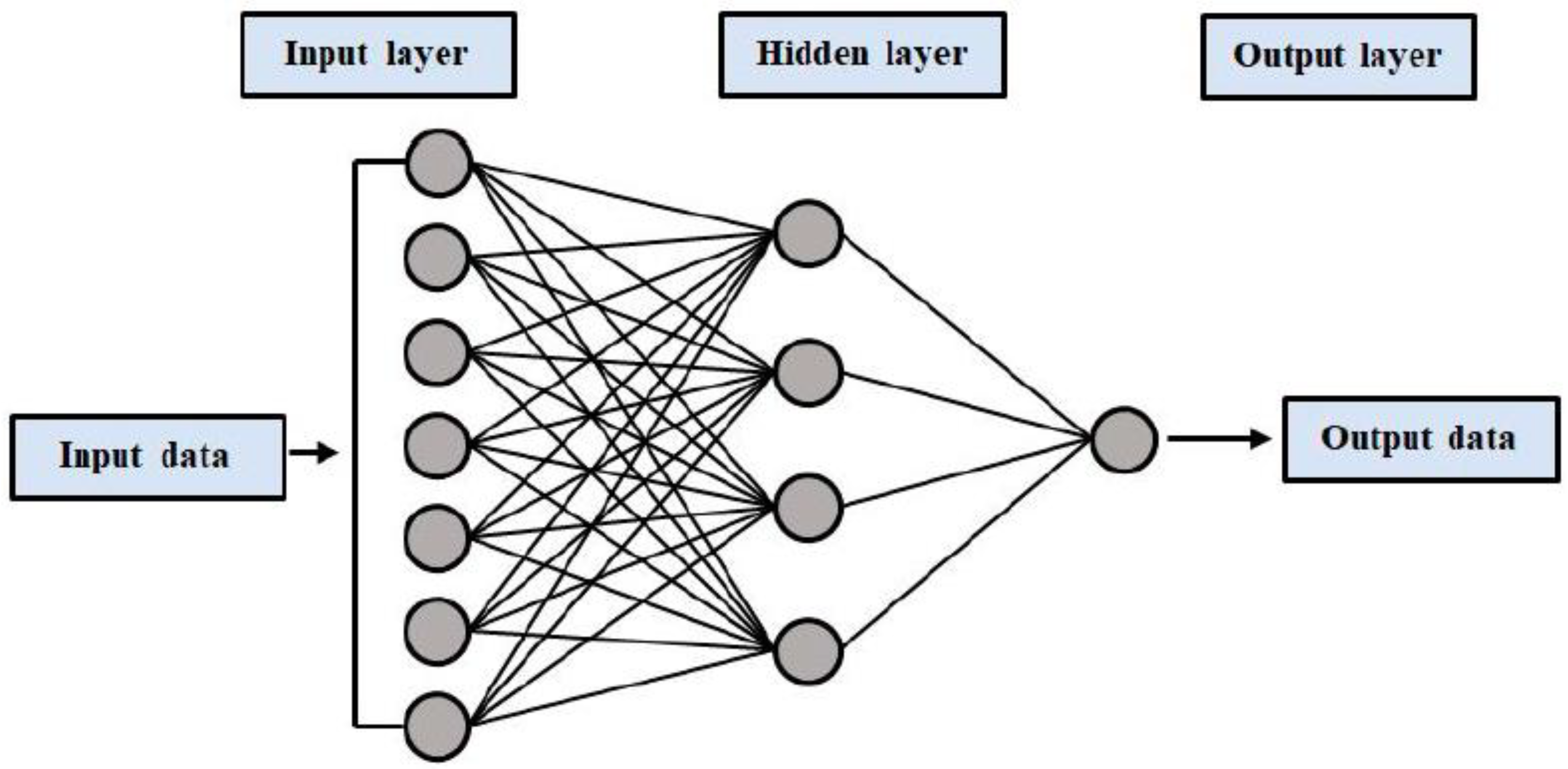
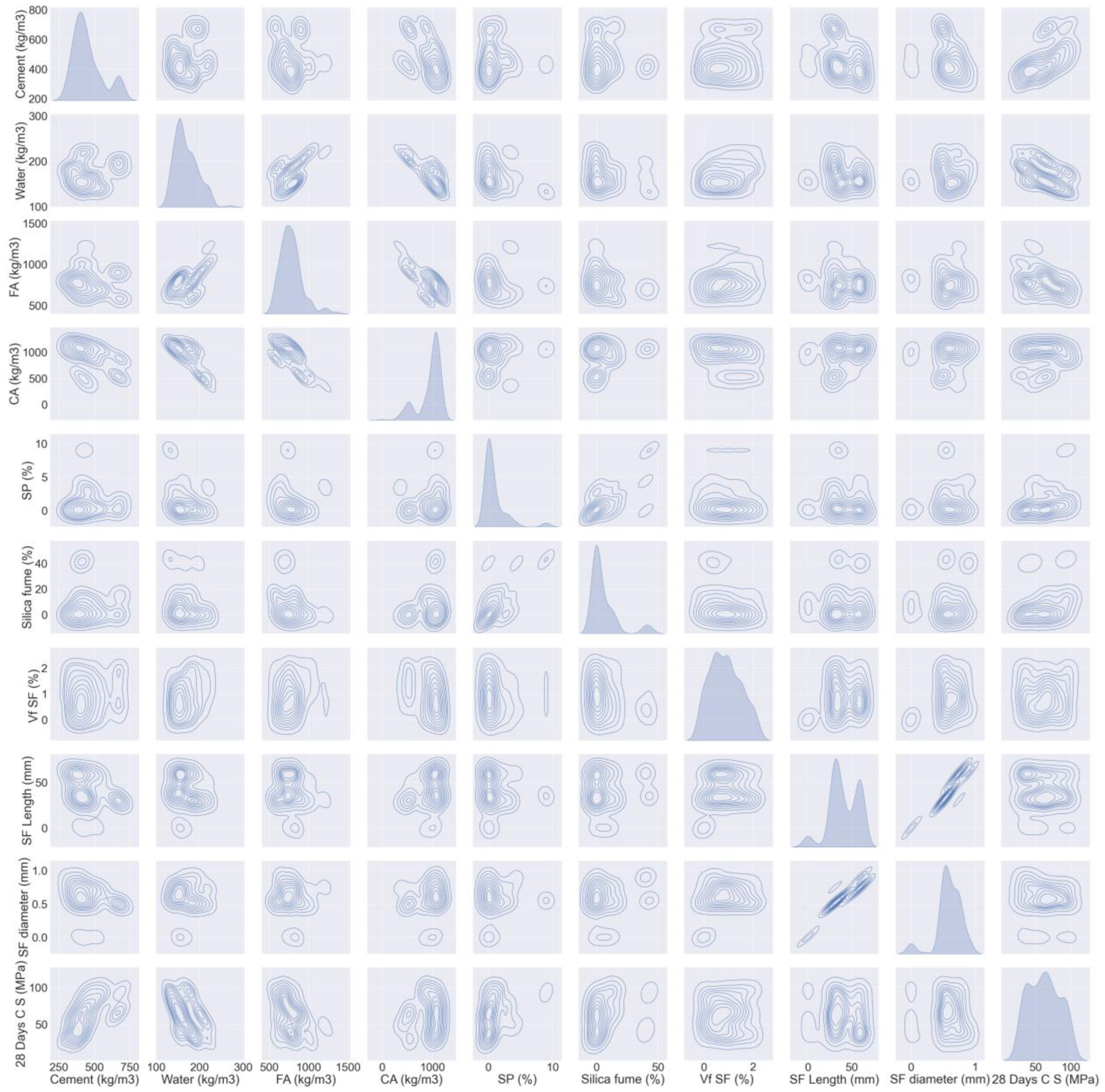
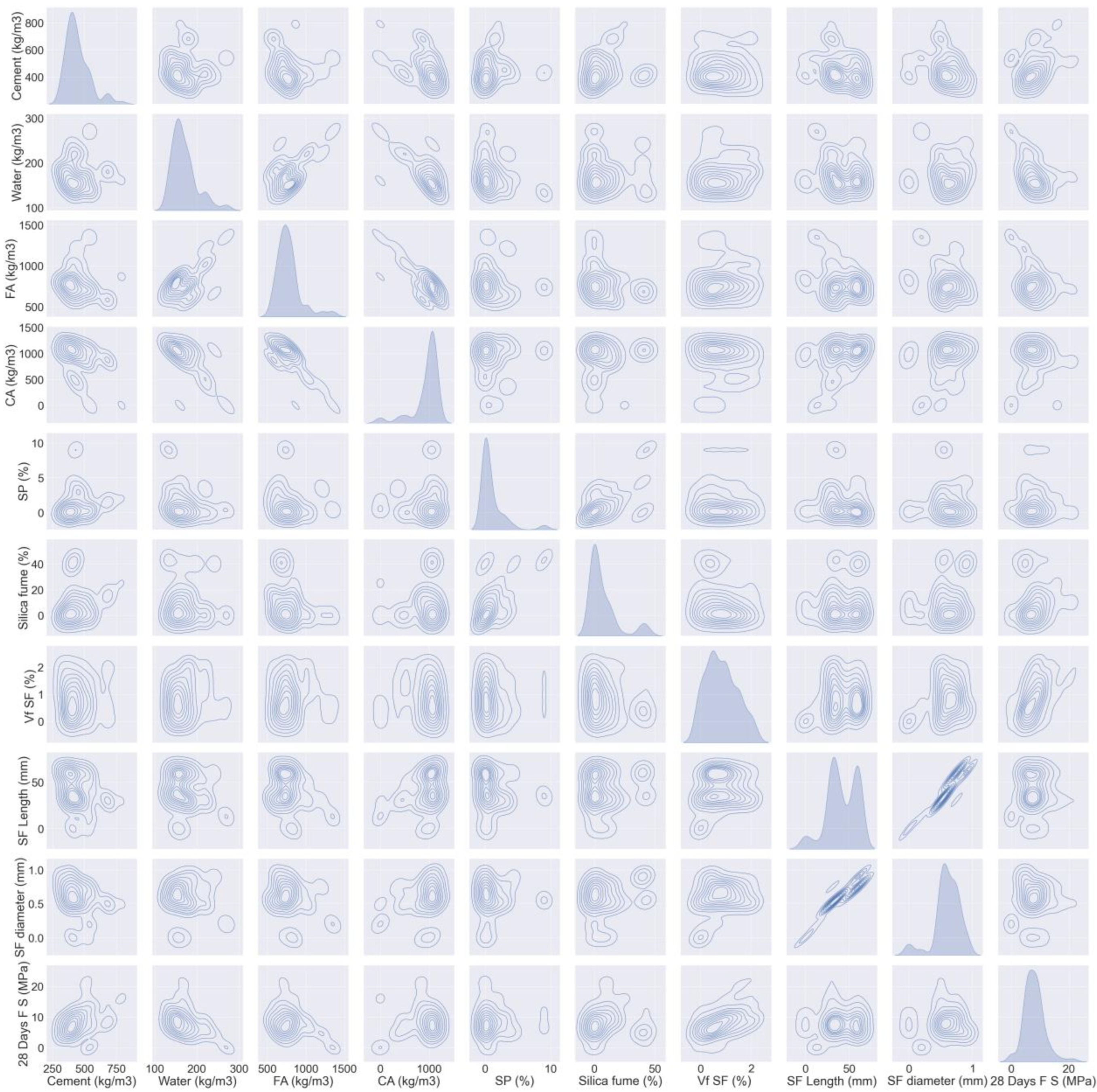
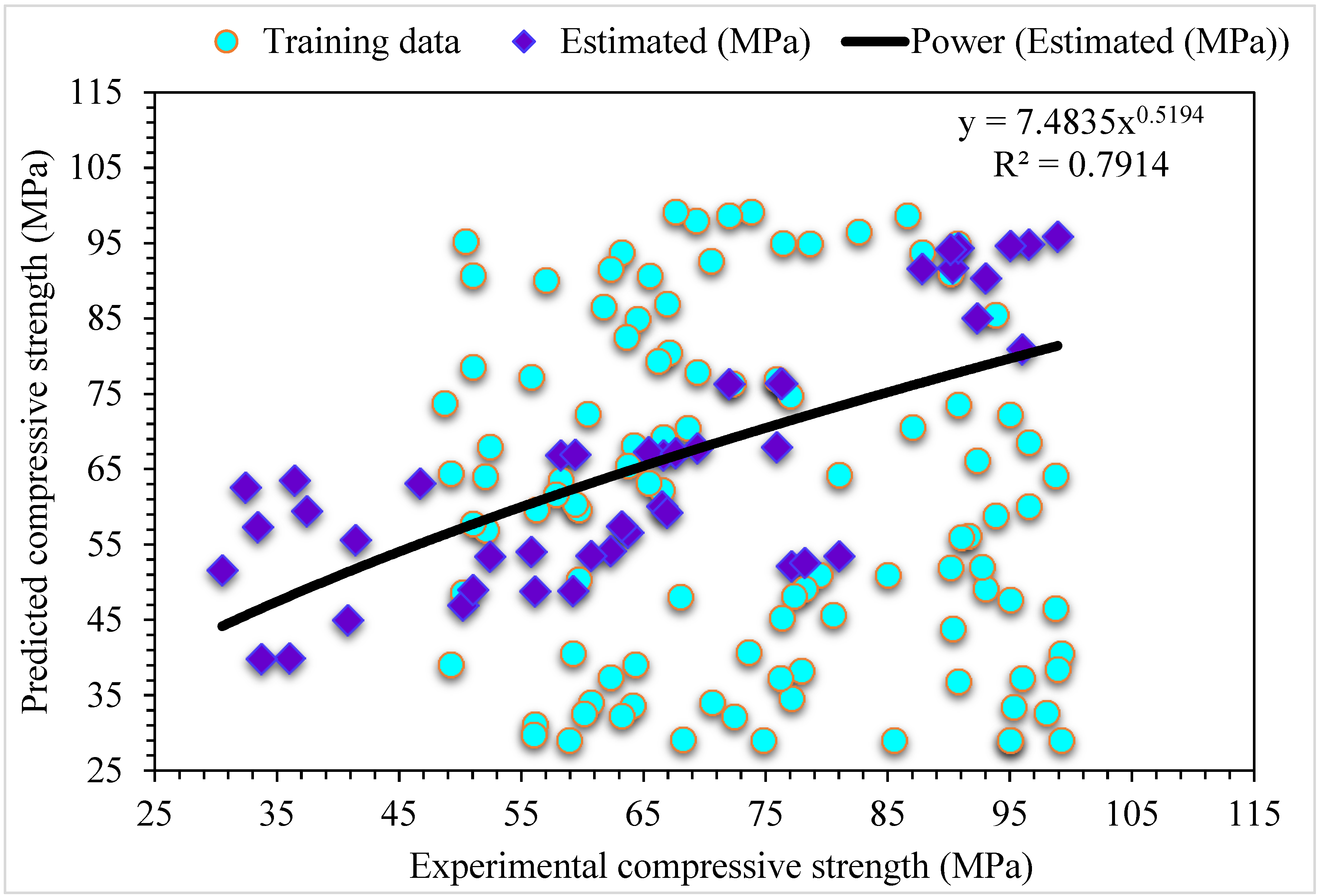

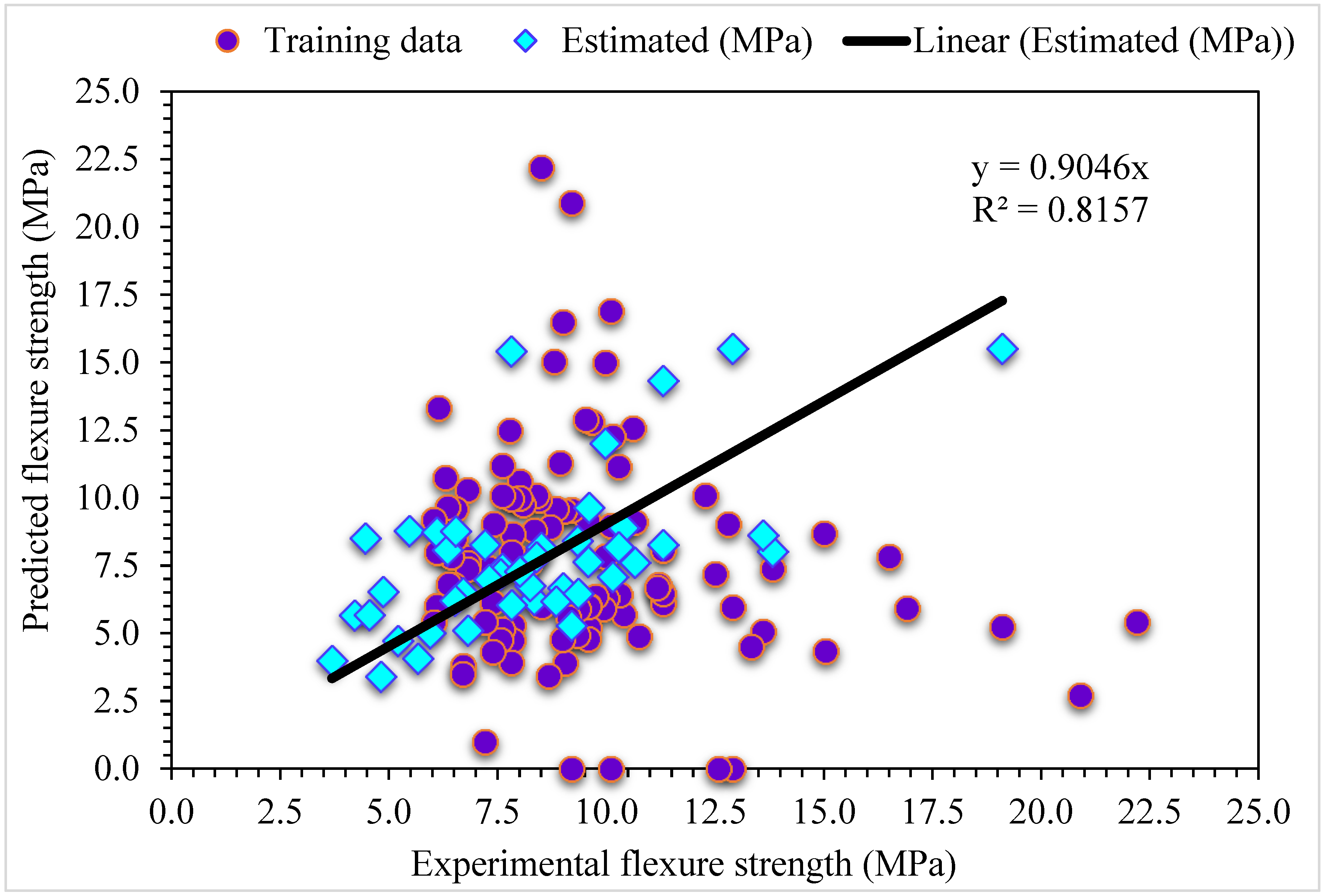
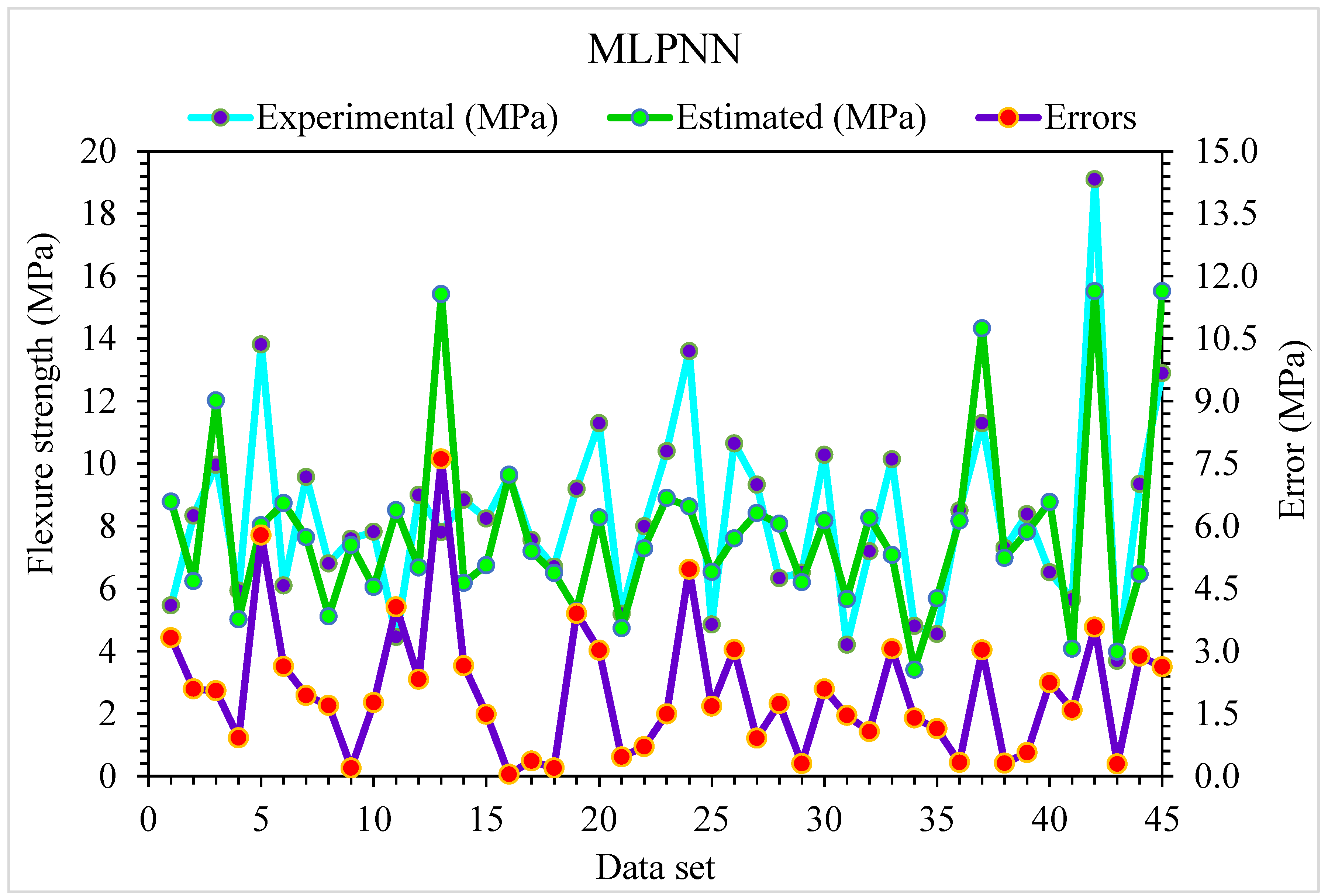
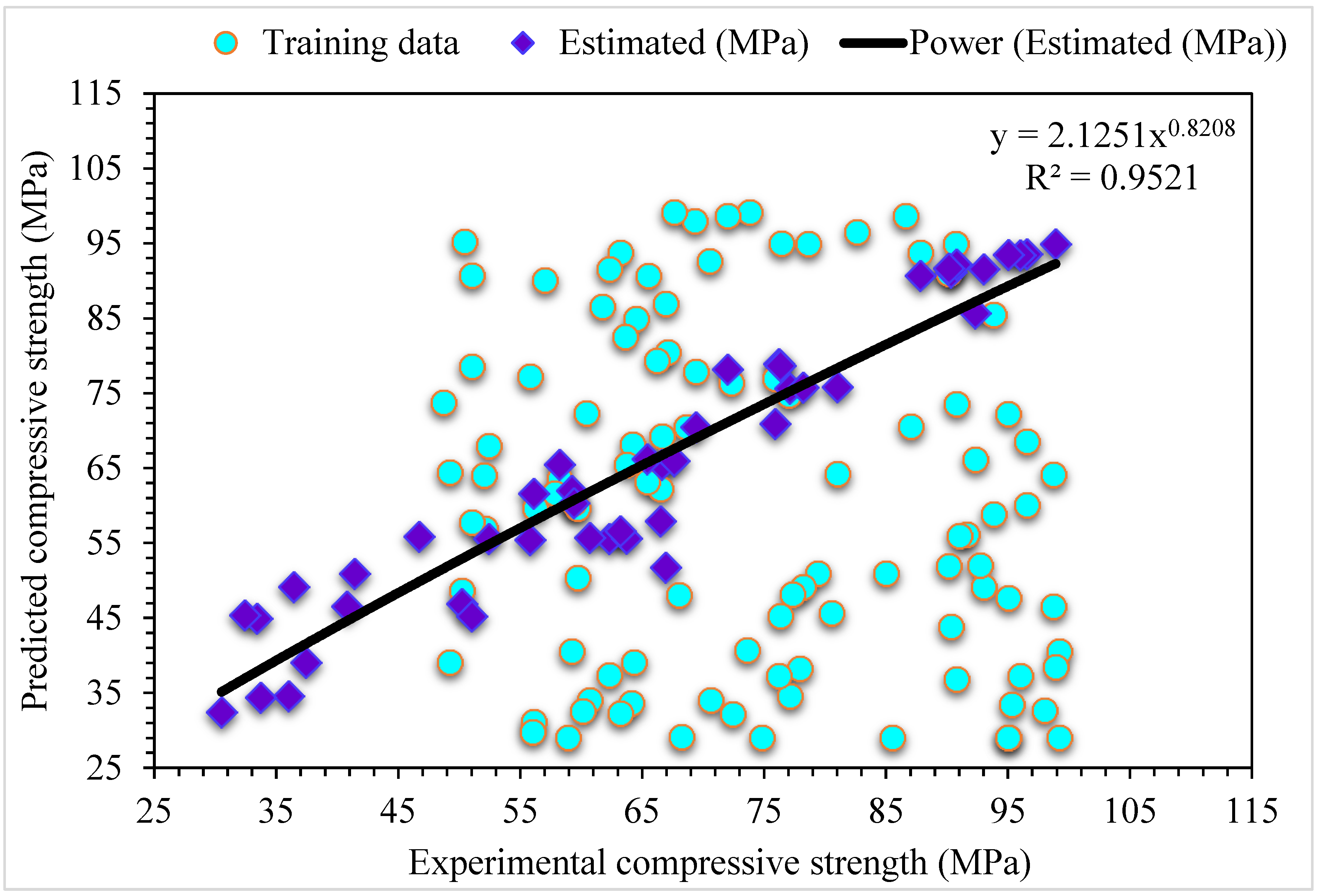



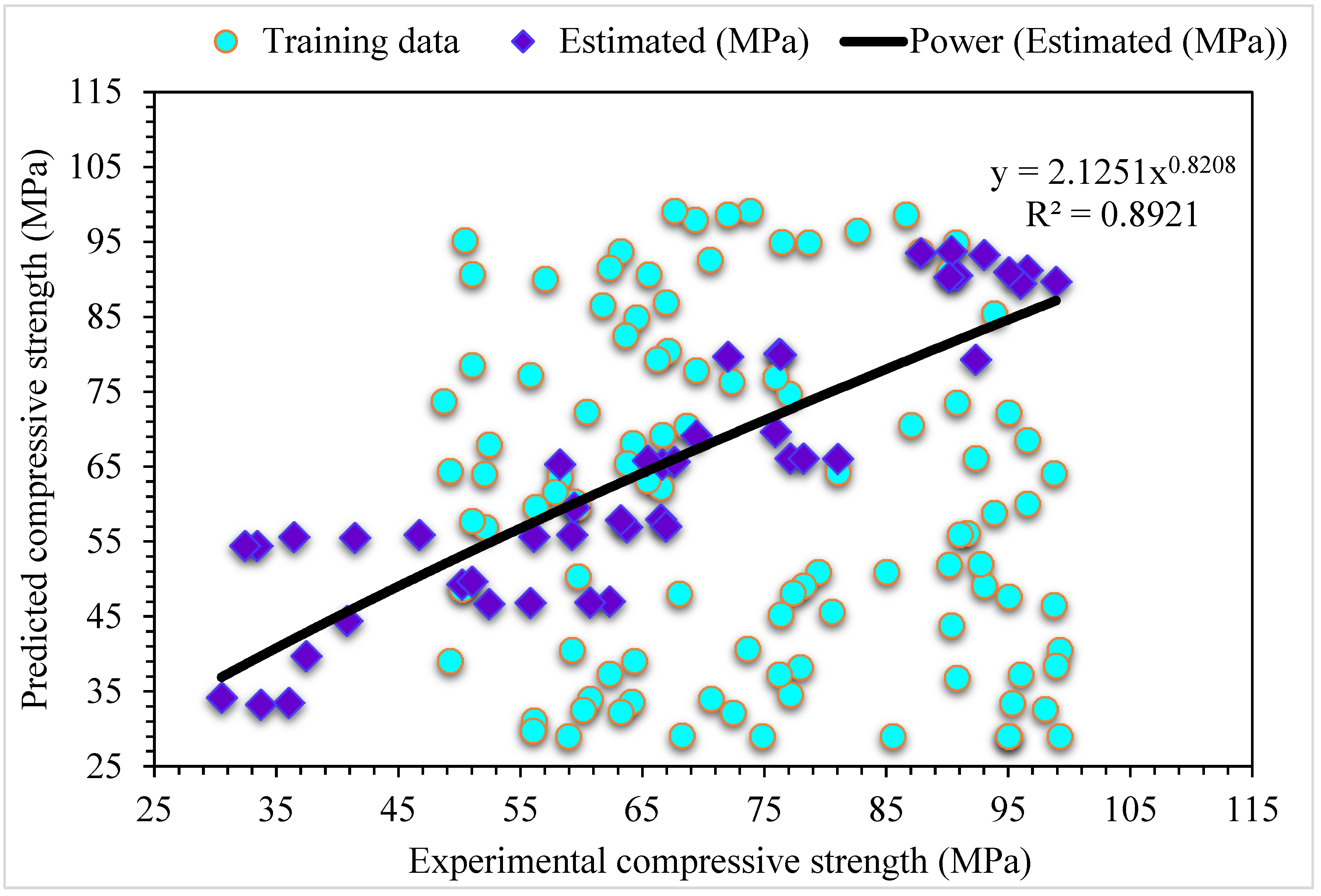

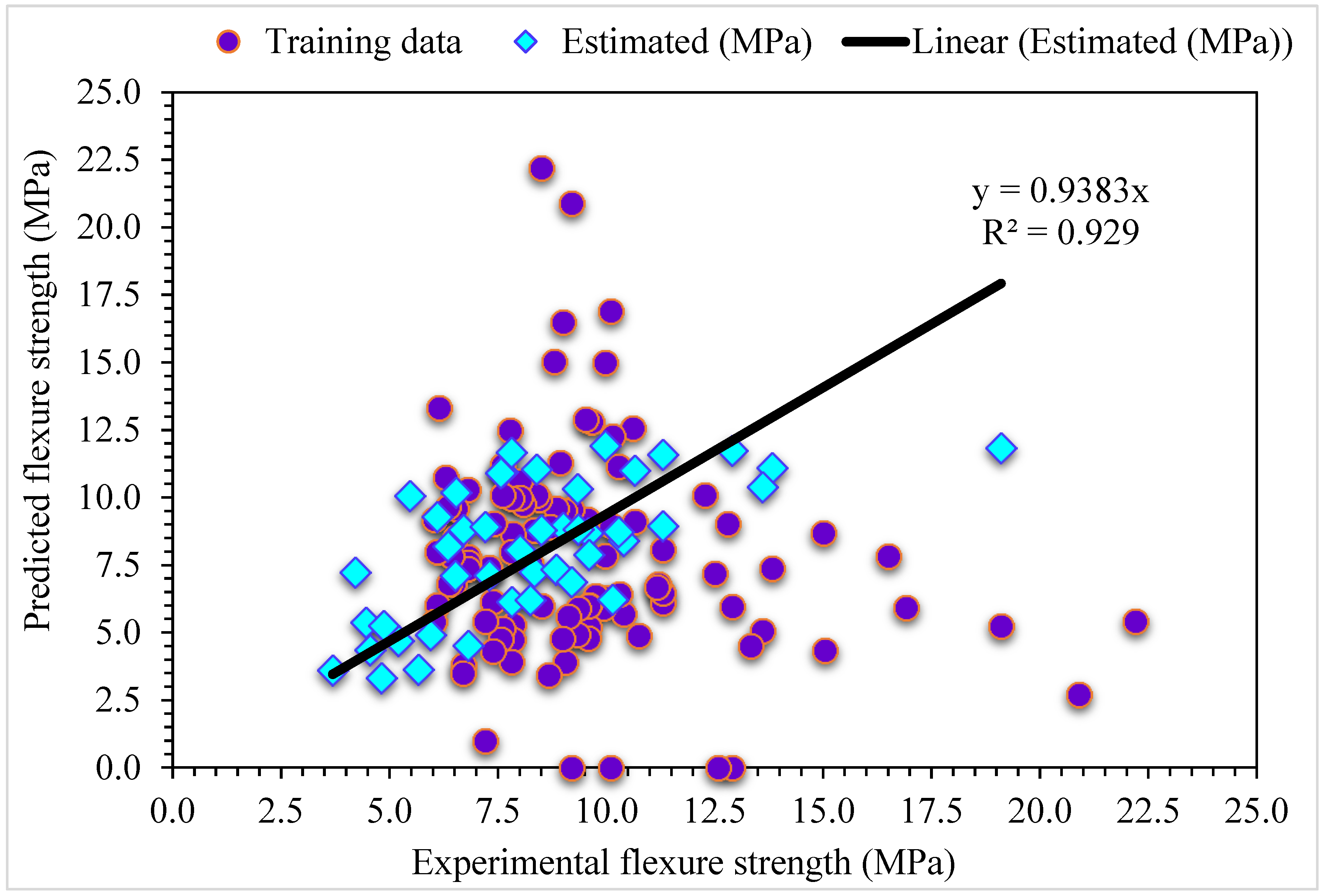
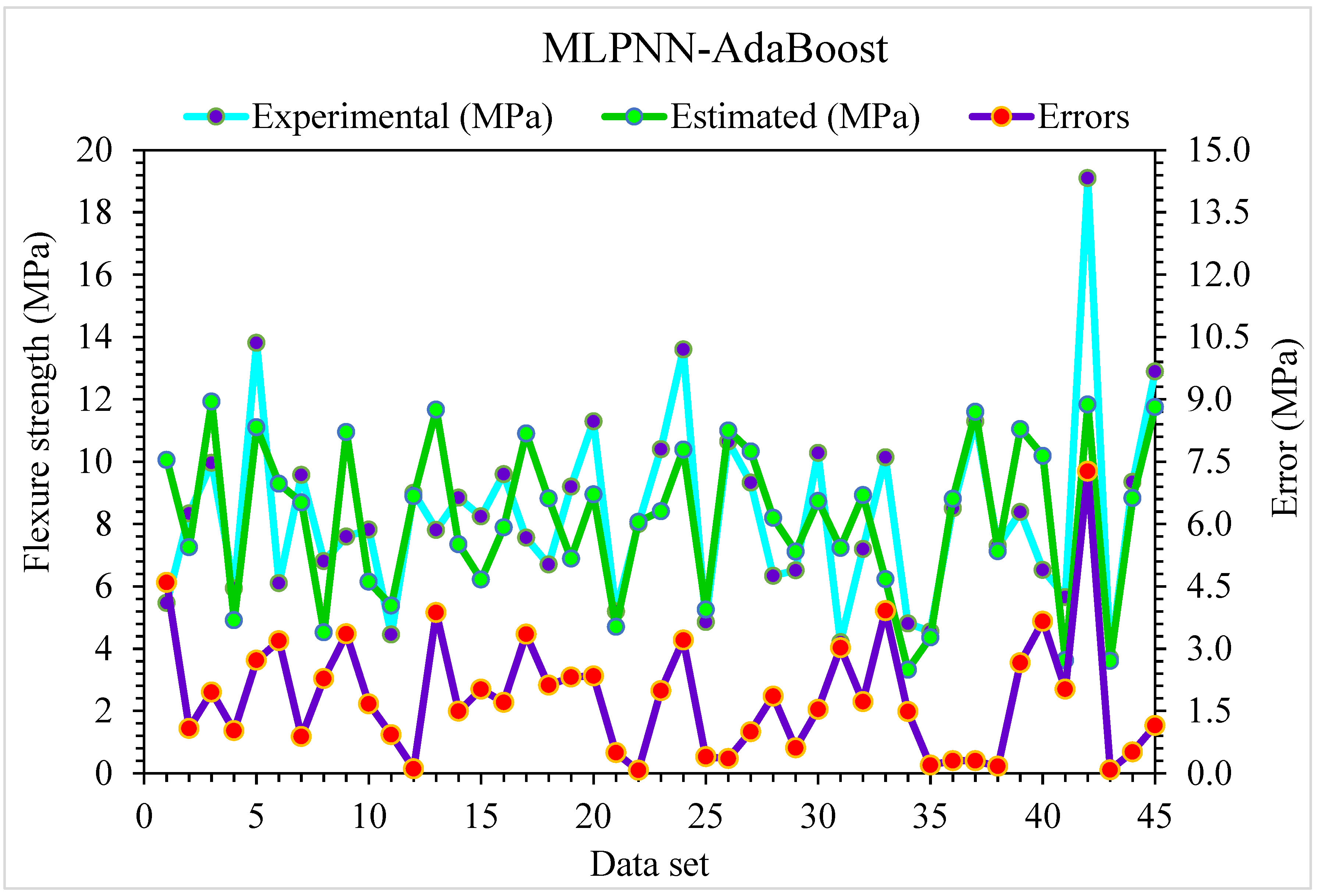
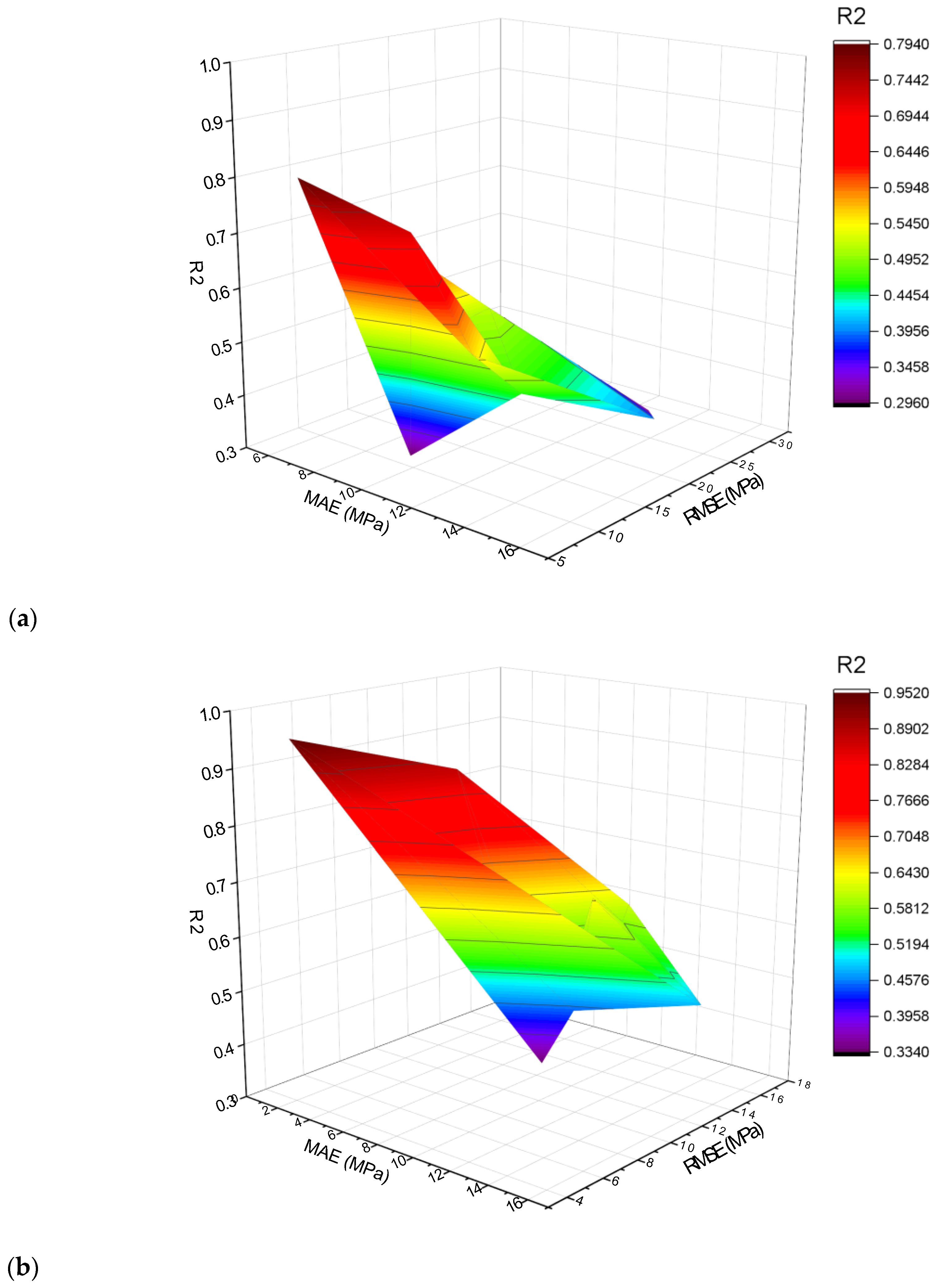
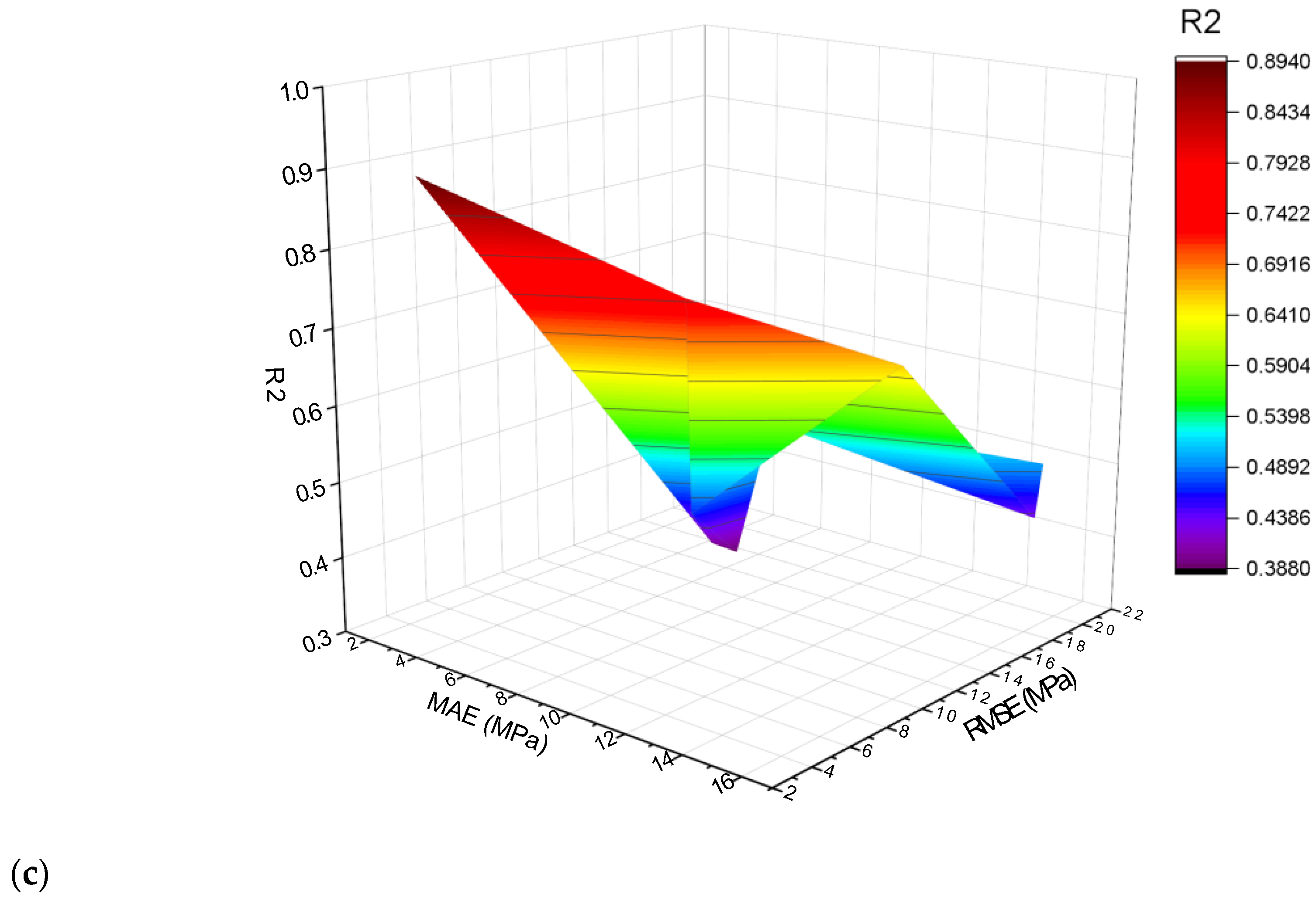

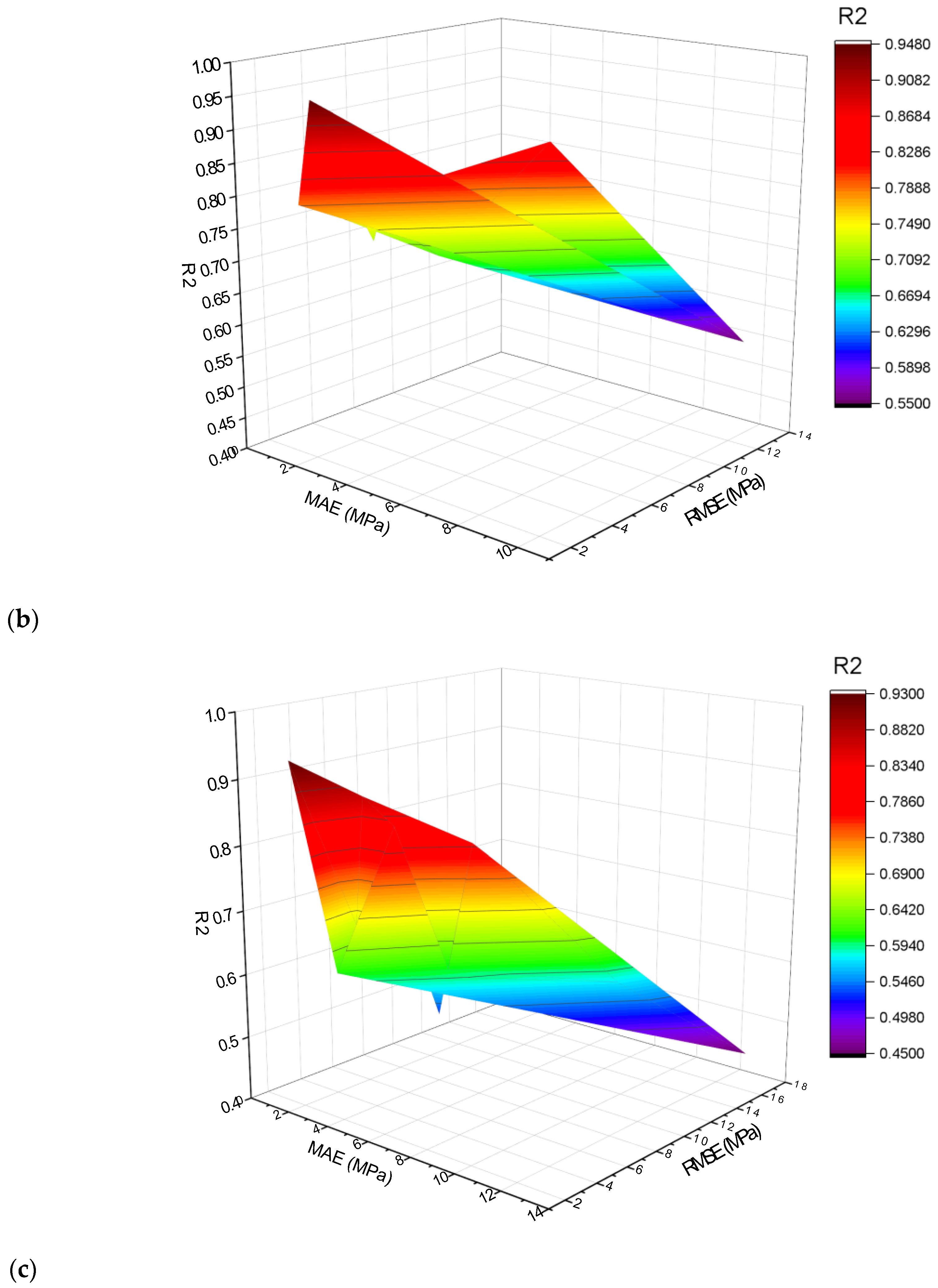

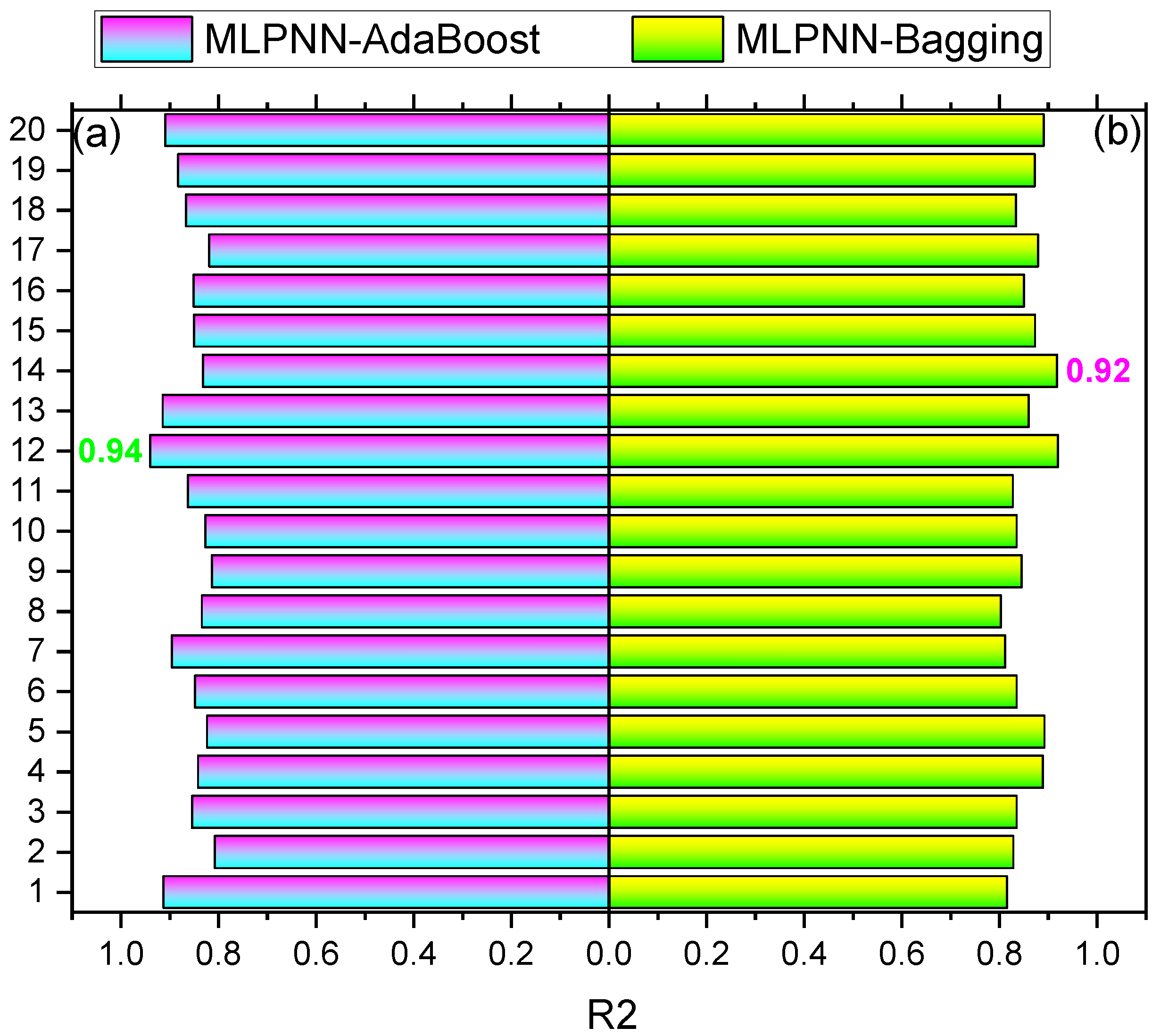
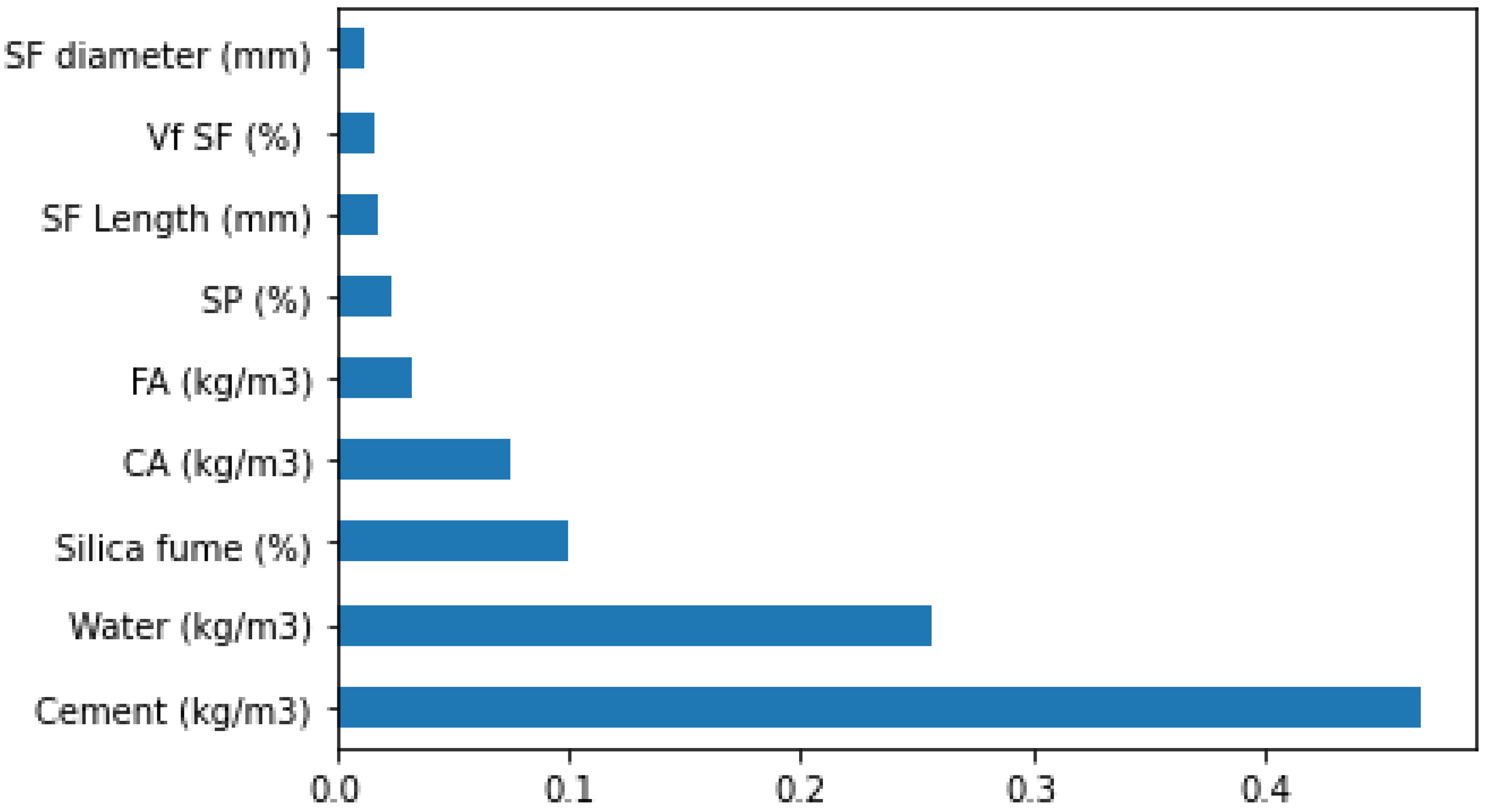

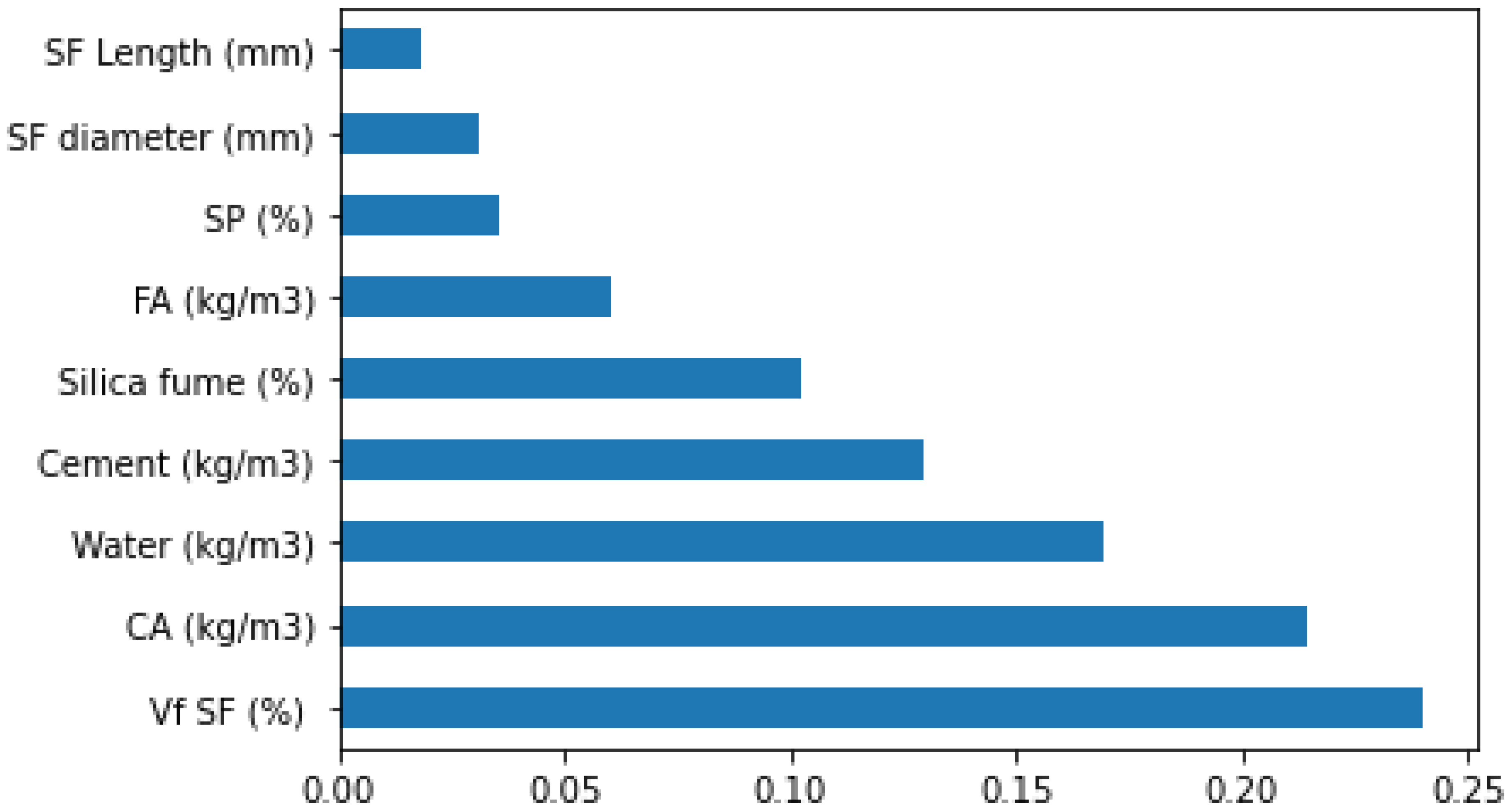

| Study Findings | Conducted Studies | ||||
|---|---|---|---|---|---|
| Purkiss [21] | Patil and Sangle [22] | Noaman, et al. [23] | Boulekbache, et al. [24] | Gholamhoseini, et al. [25] | |
| Studied Properties of SFRC | Residual Flexural Strength Residual Compressive Strength | Compressive Strength Flexural Strength | Compressive Strength Flexural Strength | Compressive Strength Flexural Strength | Compressive Strength Flexural Strength |
| Reported Outcomes | 78–91% loss@800 °C 57–74% loss@800 °C | 45.7 MPa 5.3 MPa | 47 MPa 3.0–3.9 MPa | 27–28.5 MPa 3.5–5.5 MPa | 33.8–36.2 MPa 3.9–4.3 MPa |
| Considered Applications | Refractory Material | Beams | - | Structural Beams | Slabs |
| Ref. | Material Type | Properties Predicted | ML Techniques Employed | No. of Input Parameters | Data Points | Best ML Technique Recommended |
|---|---|---|---|---|---|---|
| [42] | Concrete-Filled Steel Tubes | Ultimate axial capacity | Gene expression programming | 6 | 227 | - |
| [43] | Recycled aggregate concrete | Split-tensile strength | Gene expression programming, artificial neural network, and bagging regressor | 9 | 166 | Bagging regressor |
| [44] | Rice husk ash concrete | Compressive strength | Gene expression programming and random forest | 6 | 192 | Gene expression programming |
| [45] | Geopolymer concrete | Compressive strength | Decision tree, bagging regressor, and AdaBoost | 9 | 154 | Bagging regressor |
| [46] | Fly ash-based concrete | Compressive strength | Gene expression programming, artificial neural network, decision tree, and bagging regressor | 7 | 98 | Bagging regressor |
| [47] | Fly ash-based concrete | Compressive strength | Gene expression programming, decision tree, and bagging regressor | 8 | 270 | Bagging regressor |
| Material Type | Parameters | Techniques | MAE (MPa) | RMSE (MPa) | R2 | References |
|---|---|---|---|---|---|---|
| SFRC | Compressive strength | MLPNN | 8.7 | 12.3 | 0.79 | This study |
| SFRC | MLPNN-AdaBoost | 4.5 | 5.8 | 0.95 | This study | |
| SFRC | MLPNN-Bagging | 6.6 | 8.8 | 0.89 | This study | |
| SFRC | Flexural strength | MLPNN | 2.0 | 2.6 | 0.81 | This study |
| SFRC | MLPNN-AdaBoost | 1.6 | 2.0 | 0.94 | This study | |
| SFRC | MLPNN-Bagging | 1.8 | 2.3 | 0.92 | This study | |
| Recycled coarse aggregate concrete (RCAC) | Compressive strength | SVM-AdaBoost | 7.7 | 9.5 | 0.94 | Amin, et al. [71] |
| Geopolymer concrete | Compressive strength | MLPNN | 5.8 | 7.4 | 0.81 | Amin, et al. [72] |
| Geopolymer concrete | Compressive strength | Support vector machine | 6.7 | 8.1 | 0.78 | Amin, et al. [72] |
| Waste marble powder Concrete (WMC) | Compressive strength | DT-AdaBoost | 3.9 | 7.9 | 0.91 | Khan, et al. [73] |
| Fly ash concrete | Compressive strength | Decision Tree | - | - | 0.88 | Khan, et al. [74] |
| Fly ash concrete | Compressive strength | MLP | - | - | 0.90 | Khan, et al. [74] |
| Fly ash concrete | Compressive strength | Bagging | - | - | 0.93 | Khan, et al. [74] |
| Geopolymer concrete | Compressive strength | Decision Tree | 4.1 | 6.2 | 0.88 | Zou, et al. [75] |
| Recycled coarse aggregate concrete (RCAC) | Compressive strength | DT-XGBoost | 7.7 | 10.5 | 0.94 | Amin, et al. [71] |
Publisher’s Note: MDPI stays neutral with regard to jurisdictional claims in published maps and institutional affiliations. |
© 2022 by the authors. Licensee MDPI, Basel, Switzerland. This article is an open access article distributed under the terms and conditions of the Creative Commons Attribution (CC BY) license (https://creativecommons.org/licenses/by/4.0/).
Share and Cite
Al-Hashem, M.N.; Amin, M.N.; Ahmad, W.; Khan, K.; Ahmad, A.; Ehsan, S.; Al-Ahmad, Q.M.S.; Qadir, M.G. Data-Driven Techniques for Evaluating the Mechanical Strength and Raw Material Effects of Steel Fiber-Reinforced Concrete. Materials 2022, 15, 6928. https://doi.org/10.3390/ma15196928
Al-Hashem MN, Amin MN, Ahmad W, Khan K, Ahmad A, Ehsan S, Al-Ahmad QMS, Qadir MG. Data-Driven Techniques for Evaluating the Mechanical Strength and Raw Material Effects of Steel Fiber-Reinforced Concrete. Materials. 2022; 15(19):6928. https://doi.org/10.3390/ma15196928
Chicago/Turabian StyleAl-Hashem, Mohammed Najeeb, Muhammad Nasir Amin, Waqas Ahmad, Kaffayatullah Khan, Ayaz Ahmad, Saqib Ehsan, Qasem M. S. Al-Ahmad, and Muhammad Ghulam Qadir. 2022. "Data-Driven Techniques for Evaluating the Mechanical Strength and Raw Material Effects of Steel Fiber-Reinforced Concrete" Materials 15, no. 19: 6928. https://doi.org/10.3390/ma15196928







